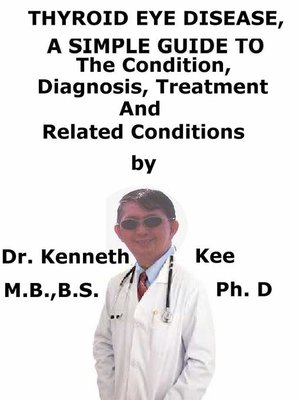Thyroid Eye Disease, a Simple Guide to the Condition, Diagnosis, Treatment and Related Conditions
ebook
By Kenneth Kee

Sign up to save your library
With an OverDrive account, you can save your favorite libraries for at-a-glance information about availability. Find out more about OverDrive accounts.
Find this title in Libby, the library reading app by OverDrive.



Search for a digital library with this title
Title found at these libraries:
| Library Name | Distance |
|---|---|
| Loading... |
Thyroid eye disease (TED) is a medical disorder marked by swelling of the muscles and fatty tissues surrounding the eyeball within the eye socket (orbit).This swelling is due to the inflammation of these tissues.There is restricted space inside the eye orbit so when the tissues swell, the eyeball is pushed forward.Cause:Thyroid eye disease is an eye condition linked to autoimmune thyroid disease.Symptoms of Thyroid disease:1. Neck thyroid swelling2. Heat intolerance3. Tremors4. Sweatiness5. Loss of weight6. PalpitationsAutoimmune thyroid disease happens when the body's antibodies attack tissues of the thyroid organ.This is called Thyroid Eye Disease, an autoimmune disease.The cause is not known exactly why this happens in some people and not in others.Symptoms are produced by the tissues of the eye socket swelling and pushing the eyeball forward:The biochemical events result in swelling of the orbital soft tissues particularly the eye muscles and orbital fat.Eye symptoms are:1. Blurring of vision2. Staring appearance of eyes3. Protrusion of the eyes4. Tearing5. Eye discomfort and gritty sensation6. Eye redness7. Puffy eyelids8. Double vision9. Squint10. Reduced visionDiagnosis:Thyroid function tests (TFTs)MRI scanTreatment:Most thyroid eye disorder gets better with good thyroid hormone control.Local therapy:Tear substitutes and lubricants help to cover the surface of the eye from drying.Sleeping on extra pillows assists to decrease swelling around the eyes.Double vision is problematic if it involves forward and down looking positions as in reading.Special lenses called prisms may give relief for this.MedicinesMedical therapy (immunosuppressive and radiotherapy) are more effective in the acute phase of the disease.In the early stage of the disease and where the disease stays mild, artificial tears (ocular lubricants) may be enough.ImmunosuppressionSteroids are given in selected cases, normally taken orallySurgerySurgical treatment is normally reserved for patients in the inactive stage.With injured vision, early lid surgery or orbital surgery is necessarySurgery is reserved normally for inactive disease.Surgical rehabitation is normally staged with orbital decompression surgery to decrease proptosis.Squint and eyelid surgeries may eliminate double vision and exposure respectively.RadiotherapyRadiotherapy may be done in some places on some patientsTABLE OF CONTENTIntroductionChapter 1 Thyroid Eye DiseaseChapter 2 CausesChapter 3 SymptomsChapter 4 DiagnosisChapter 5 TreatmentChapter 6 PrognosisChapter 7 HyperthyroidismChapter 8 GoiterEpilogue







